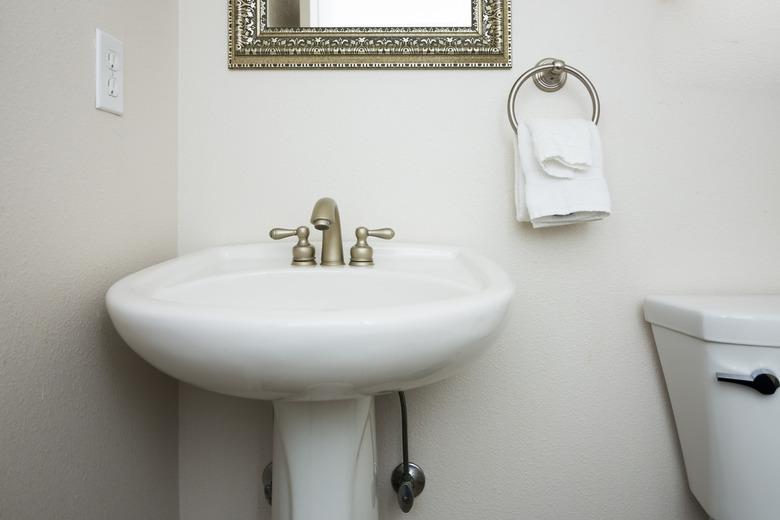Can I Use Glue To Mount A Pedestal Sink?
If you need additional bathroom space, a pedestal sink is a wiser choice than a vanity. Although free-standing pedestal sinks lack the storage you would have with a traditional sink and cabinet setup, they take up less space, making your bathroom appear larger. With their attractive glazed porcelain finish, pedestal sinks can add a touch of class and elegance to your bathroom. Correctly gluing a sink to the wall takes keeping a few tips in mind in order to avoid accidents and possible injuries.
Tip
You can mount a pedestal sink with glue as long as you take steps to safely secure it.
Connecting Sink to Wall
Pedestal sinks come in two separate pieces: the sink bowl and the stand. Depending on how the pipes in your bathroom are set up, it may be necessary to contact a plumber to run the water and drain lines for your pedestal sink. Once the plumbing part of the installation is taken care of, it's time to mount the sink to the pedestal using sink adhesive.
You can mount the sink bowl either with lag screws or by gluing a sink bowl to the pedestal with construction adhesive. While construction adhesive creates a strong bond between the sink bowl and pedestal, if you ever need to separate the two pieces, doing so will prove challenging — if not impossible.
Securing the Sink
Your pedestal sink's bowl must not only be connected to the pedestal beneath it but to the wall as well. Gluing the sink bowl to the wall with construction adhesive is a slightly more common practice than to attach pedestal sink bowl directly to the pedestal.
If you are not comfortable gluing your sink bowl directly to the wall, you have an alternative in the form of metal brackets. Metal brackets screwed into the wall serve as a durable and glue-free way to mount your pedestal sink bowl. When installed properly, brackets are just as sturdy as glue – sometimes more so.
Risks of Gluing a Sink
Attaching the sink bowl to the pedestal or wall with adhesive is often a simpler procedure than connecting the sink bowl with metal brackets, but it has its risks. For example, a small child who cannot see over the sink while brushing his teeth may pull on the sink bowl.
If the sink bowl was installed with adhesive alone, it is more likely to pull loose from the wall or pedestal, resulting in possible injury or a broken sink bowl. Thus, if you have small children in your home, connecting the sink via metal brackets rather than adhesive is a smart option.
Using Adhesive Caulking
For the most secure sink possible, consider using both metal brackets and adhesive. While you can't apply construction adhesive after securing the sink and pedestal via metal brackets, you can introduce a different kind of adhesive: caulk.
It's necessary to caulk around the base of the pedestal and the area where the rear of the sink bowl meets the wall. This prevents moisture from getting trapped behind your sink and facilitating mold and mildew growth. The U.S. Department of Energy recommends silicone household caulking compound for bathroom applications. Find such caulking to attach pedestal sinks at a variety of locations, including Amazon and Home Depot.
